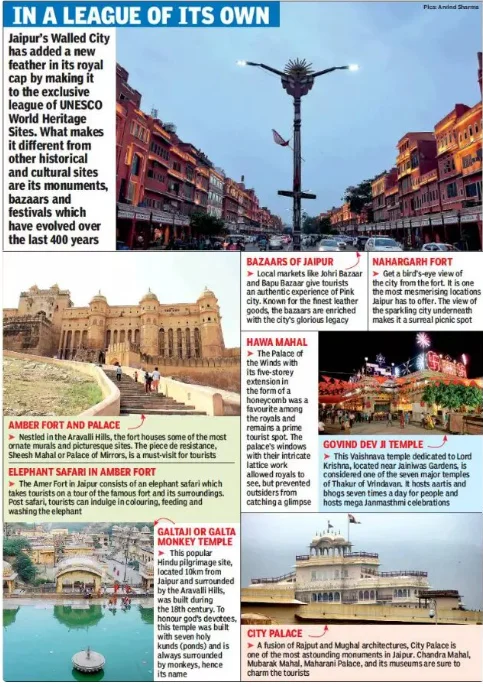Rajasthan Switch to Hindi
Jaipur’s Walled City
Why in News?
UNESCO has asked Rajasthan’s Department of Archaeology & Museums to submit a detailed status report on the conservation and management of the Jaipur Walled City, following concerns over urban pressures, unregulated construction.
Key Points
- The Jaipur Walled City was inscribed as a UNESCO World Heritage Site (2019) for being an exceptional example of 18th-century planned urban architecture.
- Founded in 1727 by Maharaja Sawai Jai Singh II, it is based on Vedic principles and a gridiron plan with broad streets, chowkris, and uniform bazaars. Unlike other cities in the region located in hilly terrain, Jaipur was established on the plain.
- It is known for its living culture, crafts, gemstone trade, handlooms, and vibrant bazaar ecosystem.Key features include City Palace, Hawa Mahal, Govind Dev Ji Temple, Jantar Mantar, traditional pink façades, city gates, and interconnected markets.
- It is managed under frameworks like the Conservation Management Plan (CMP), Integrated Management Plan, and State-level Heritage Regulations governing façade control, building height, colour uniformity, and signage norms.
- Threats include urban congestion, encroachments, structural strain, unregulated commercialisation, and loss of traditional architectural character.
Rajasthan Switch to Hindi
Rajasthan to Conduct Its First Tiger Translocation
Why in News?
Rajasthan is planning for its first-ever interstate tiger translocation, which will also be India’s second such translocation of a wild tiger from one landscape to another.
- The first inter-state translocation involved two tigers: a male from Kanha Tiger Reserve and a female from Bandhavgarh Tiger Reserve (both Madhya Pradesh) to Satkosia Tiger Reserve (Odisha) in 2018 but it failed.
Key Points
- About the Translocation:
- A tigress from Pench Tiger Reserve (Madhya Pradesh) will be airlifted to the Ramgarh Vishdhari Tiger Reserve (RVTR) in Bundi, after obtaining final approvals from the National Tiger Conservation Authority (NTCA).
- The translocation aims to introduce genetic diversity and establish a viable breeding population in RVTR.
- The tigress will be fitted with a GPS radio-collar to enable real-time monitoring, movement analysis, and early detection of potential conflict or stress.
- Rajasthan’s Forest Department is coordinating with experts in wildlife science to ensure that the operation follows IUCN translocation protocols, including pre-release habitat assessment and post-release surveillance.
- About Ramgarh Vishdhari Tiger Reserve (RVTR):
- Ramgarh Vishdhari Tiger Reserve is located in the Bundi district of Rajasthan, with its landscape extending toward Kota and Bhilwara regions.
- The reserve lies within the ancient Aravalli hill ranges, featuring seasonal rivers such as Mej, Ramgarh, and Khari, which support its semi-arid forest ecosystem.
- It was notified as Rajasthan’s fourth Tiger Reserve in 2022, after Ranthambore, Sariska, and Mukundra Hills Tiger Reserve.
- RVTR was created from the Ramgarh Vishdhari Wildlife Sanctuary along with adjoining forest blocks and corridors that connect it to the Ranthambore Tiger Reserve, forming an important tiger dispersal route.
- The habitat consists of dry deciduous forests, open scrublands, grass patches, and riverine zones, making it a suitable landscape for tiger movement and prey base recovery.


.png)










.png)


.jpg)



 PCS Parikshan
PCS Parikshan


